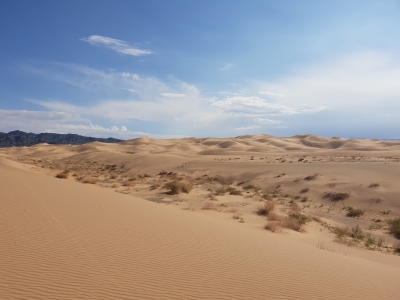
Spanning large parts of southern Mongolia and northern China the Gobi Desert is the largest desert in Asia and the fifth largest in the world. This cold desert is in the rain shadow of the Himalayas. It covers an area of about 13.00,000 sq.km, and despite its popularity as a desert, a large expanse of the region is bare rock. The Desert is almost entirely waterless, but there are salt marshes within its confines. Since it is spread across a vast area, the place has been divided into five distinct ecoregions, including those exhibiting characteristics of semi-desert and desert steppes. The conditions are harsh, and the climate, remarkably extreme in several areas with very cold winters and very humid summers. The vegetation is sparse in the region, and is dominated by succulents, desert grass, and bushes. Despite this, the region exhibits variety in terms of birds, animals, insects and the like.
This cold desert is also of great importance to study the evolution of life on our planet, since fossils of dinosaurs and mammals dating back to millions of years have been excavated from here. As with most places across the world, the Gobi Desert has its share of concerns too, chief among them being desertification.
Wildlife
Despite the sparse vegetation, several species of birds can be spotted in the region. Among them are falcons, sandgrouses, Mongolian groundjays, wheatears, sparrows, plovers, warblers, cuckoos, owls, doves, pigeons, cranes. hoopoes, partridges, stints gulls, terns, lapwings, stilts, grebes, spoonbills, egrets ,herons, kestrels, pintails, geese, ducks, pochards, eagles, goshawks, buzzards, vultures, bustards, cormorants, stonechats, redstarts, flycatchers, tits, starlings, thrushes, buntings, wagtails, pipits, and larks. Among the animals found here are Bactrian camels, foxes, wolves, gazelles, antelopes, Mongolian wild ass, Gobi ibex bears, and rodents such as marmots and jerboas. The snow leopard is said to inhabit the Desert too and is among the chief predators. In addition to snake species such as pit vipers and many varieties of frogs, the region hosts about 30 species of lizards that thrive well in and around the desert sands.
Threats
- Desertification refers to the degradation of fertile land to dry land. Among reasons that cause this are climate change and human activity Desertification has severe ecological and environmental impact. The Gobi Desert is the fastest growing desert today. Due to this, several km of grassland has been gradually turning into wasteland with each passing day
- Overgrazing of livestock too is considered one of the reasons for the desertification of lands. Not just that it also has led to the reduction in the quality of existing desert soil, thereby depriving the soil of sources of nutrients that support life.
- In addition to these, over-cultivation badly drained irrigation systems and the mismanagement of water in the region risk to this ecosystem. When the environment is thus affected, it invariably affects the wildlife in the region too. Since the area pose a supports millions of people, long-term degeneration will have a negative impact on humans also. There have been reports of mining in the area, and it has been of grave concern.
Picture Credit : Google




